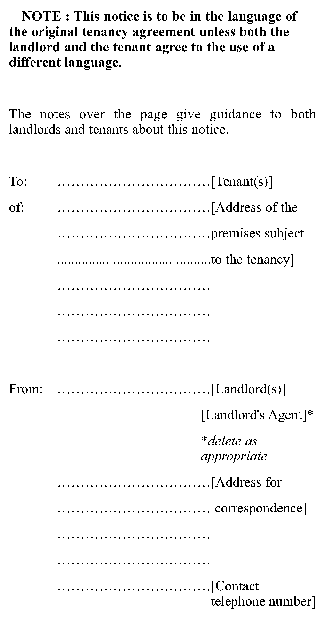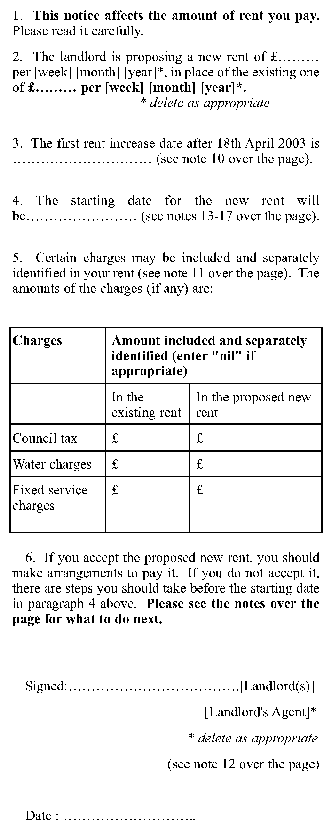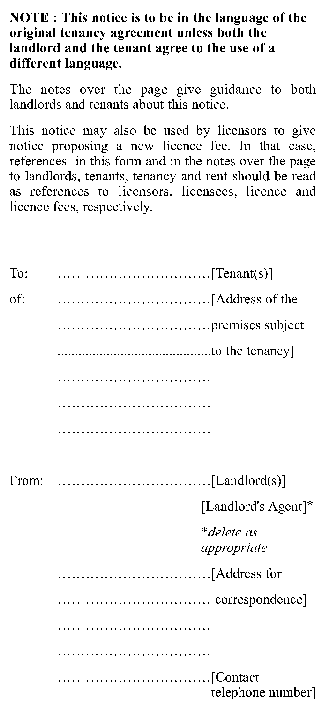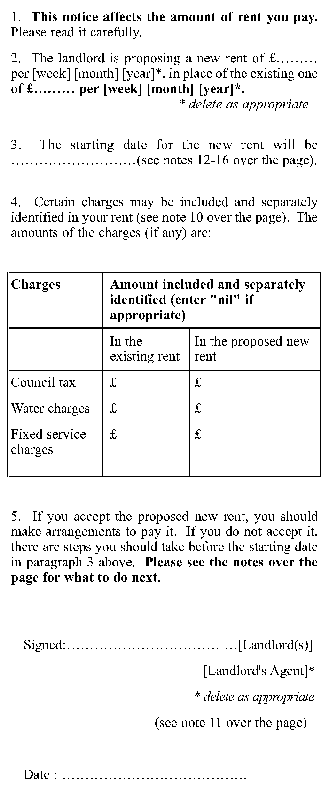- Y Diweddaraf sydd Ar Gael (Diwygiedig) - Saesneg
- Y Diweddaraf sydd Ar Gael (Diwygiedig) - Cymraeg
- Gwreiddiol (Fel y'i Gwnaed) - Saesneg
- Gwreiddiol (Fel y'i Gwnaed) - Cymraeg
The Assured Tenancies and Agricultural Occupancies (Forms) (Amendment) (Wales) Regulations 2003
You are here:
- Offerynnau Statudol Cymru
- 2003 No. 307 (W. 46)
- Whole Instrument
- Blaenorol
- Nesaf
Status:
Dyma’r fersiwn wreiddiol (fel y’i gwnaed yn wreiddiol).
Welsh Statutory Instruments
2003 No. 307 (W.46)
LANDLORD AND TENANT, WALES
The Assured Tenancies and Agricultural Occupancies (Forms) (Amendment) (Wales) Regulations 2003
Made
17th February 2003
Coming into force in accordance with Regulation 1(2)
Name, commencement and application
1.—(1) These Regulations are called the Assured Tenancies and Agricultural Occupancies (Forms) (Amendment) (Wales) Regulations 2003.
(2) These Regulations come into force as follows —
(a)Regulations 1 and 2 on 18th February 2003; and
(b)Regulation 3 on 18th April 2003.
(3) These Regulations apply only in relation to premises situated in Wales.
Amendment of Prescribed Forms
2.—(1) The Assured Tenancies and Agricultural Occupancies (Forms) Regulations 1997(3) (“the 1997 Regulations”) are amended as follows.
(2) After regulation 3(da) of the 1997 Regulations insert the following two new sub-paragraphs —
“(db)for a notice under section 13(2) proposing a new rent for an assured tenancy of premises situated in Wales, Form No. 4D;
(dc)for a notice under section 13(2) proposing a new rent or licence fee for an assured agricultural occupancy of premises situated in Wales, Form No. 4E;”
(3) In the Schedule to the 1997 Regulations, after Form No. 4C insert the forms in the Schedule to these Regulations.
Revocation and saving
3.—(1) Form No. 4 set out in the Schedule to the 1997 Regulations is hereby revoked.
(2) Nothing in paragraph (1) above affects the validity of a notice under section 13(2) of the Housing Act 1988 (notice proposing a new rent) served before the coming into force of this regulation if, at the date of service of the notice, the notice was in Form No. 4 or in a form substantially to the same effect.
Signed on behalf of the National Assembly for Wales under section 66(1) of the Government of Wales Act 1998(4)
D.Elis-Thomas
The Presiding Officer of the National Assembly
17th February 2003
Regulation 2(3)
SCHEDULEFORMS PRESCRIBED FOR THE PURPOSES OF SECTION 13(2) OF THE HOUSING ACT 1988
FORM No.4DHousing Act 1988 Section 13(2) as amended by the Regulatory Reform (Assured Periodic Tenancies) (Rent Increases) Order 2003Landlord’s Notice proposing a new rent under an Assured Periodic Tenancy of premises situated in Wales.
. Please read these notes carefully.
Guidance notes for tenants
What you must do now
1. This notice proposes that you should pay a new rent from the date specified in paragraph 4 of the notice. If you are in any doubt or need advice about any aspect of this notice, you should immediately either discuss it with your landlord or take it to a citizens' advice bureau, a housing advice centre, a law centre or a solicitor.
2. If you accept the proposed new rent, please make arrangements to pay it. If you pay by standing order through your bank, you should inform them that the amount has changed. You should also notify your Housing Benefit office, if you are claiming benefit. If you are worried that you might not be able to pay your rent, you should seek advice from a citizens' advice bureau or housing advice centre.
3. If you do not accept the proposed new rent, and do not wish to discuss it with your landlord, you can refer this notice to your local rent assessment committee. You must do this before the starting date of the proposed new rent in paragraph 4 of the notice. You should notify your landlord that you are doing so, otherwise he or she may assume that you have agreed to pay the proposed new rent.
4. To refer this notice to the local rent assessment committee, you must use the form Application referring a notice proposing a new rent under an Assured Periodic Tenancy or Agricultural Occupancy to a Rent Assessment Committee. You can obtain this from a rent assessment panel, housing advice centre or legal stationer (details can be found in the telephone directory).
5. The rent assessment committee will consider your application and decide what the maximum rent for your home should be. In setting a rent, the committee must decide what rent the landlord could reasonably expect for the property if it were let on the open market under a new tenancy on the same terms. The committee may therefore set a rent that is higher, lower or the same as the proposed new rent.
Guidance notes for landlords on how to complete the notice
6. You can complete this notice in ink or arrange for it to be printed.
7. This notice should be used when proposing a new rent under an assured periodic tenancy (including an assured shorthold periodic tenancy) of premises situated in Wales. There is a different notice (Form 4E — Landlord’s or Licensor’s Notice proposing a new rent or licence fee under an Assured Agricultural Occupancy of premises situated in Wales) for proposing a new rent or licence fee for an assured agricultural occupancy of premises situated in Wales.
8. Do not use this notice if the tenancy agreement contains a term allowing rent increases, or there is some other basis such as a separate agreement with the tenant for raising the rent. Any provision you rely on needs to be binding on the tenant. Legal advice should be sought if there is any doubt on this score.
9. You need to use a different form to propose a rent increase for a statutory periodic tenancy (the first exception mentioned in note 16) if you are seeking to adjust rent solely because of a proposed change of terms under section 6(2) of the Housing Act 1988. Seek legal advice if you think this may apply to you. You can obtain the form headed Notice proposing different terms for a Statutory Periodic Tenancy from a rent assessment panel or a legal stationer.
10. Unless the tenancy is a new one, or one of the exceptions mentioned in note 16 applies, you must insert in paragraph 3 of the notice the first date after 18th April 2003 on which rent was increased under this statutory notice procedure. That date determines the date that you can specify in paragraph 4 of the notice. See also note 15.
11. You should enter in each of the boxes in the second and third columns of the table in paragraph 5 either “Nil” or the amount of the existing or proposed charge. You should only enter amounts for council tax and water rates where the tenant does not pay these charges directly. You should only enter fixed service charges which are payable by the tenant in accordance with a term or condition which specifies that these charges will be included in the rent for the tenancy. Only enter an amount for service charges where the tenant has agreed to pay a fixed sum. Do not include in the table any variable service charge, i.e. a service charge within the meaning of section 18 of the Landlord and Tenant Act 1985, where the whole or part of the sum payable by the tenant varies or may vary according to costs.
12. You or your agent (someone acting on your behalf) must sign and date this notice. If there are joint landlords, each landlord must sign unless one signs on behalf of the rest with their agreement. The signature does not have to be hand-written if, for instance, the form is being printed or if you wish to use a laser or autosignature.
When the proposed new rent can start
13. The date in paragraph 4 of the notice must comply with the three requirements of section 13(2) of the Housing Act 1988, as amended by the Regulatory Reform (Assured Periodic Tenancies) (Rent Increases) Order 2003.
14. The first requirement, which applies in all cases, is that a minimum period of notice must be given before the proposed new rent can take effect. That period is:
one month for a tenancy which is monthly or for a lesser period, for instance weekly or fortnightly;
six months for yearly tenancy;
in all other cases, a period equal to the length of the period of the tenancy — for example, three months in the case of a quarterly tenancy.
15. The second requirement applies in most cases (but see note 16 for two exceptions):
(a)the starting date for the proposed new rent must not be earlier than 52 weeks after the date on which the rent was last increased using this statutory notice procedure or, if the tenancy is new, the date on which it started, unless
(b)that would result in an increase date falling one week or more before the anniversary of the date in paragraph 3 of the notice, in which case the starting date must not be earlier than 53 weeks from the date on which the rent was last increased.
This allows rent increases to take effect on a fixed day each year where the period of a tenancy is less than one month. For example, the rent for a weekly tenancy could be increased on, say, the first Monday in April. Where the period of a tenancy is monthly, quarterly, six monthly or yearly, rent increases can take effect on a fixed date, for example, 1st April.
16. The two exceptions to the second requirement, which apply where a statutory tenancy has followed on from an earlier tenancy, are:
where the tenancy was originally for a fixed term (for instance, 6 months), but continues on a periodic basis (for instance, monthly) after the term ends; and
where the tenancy came into existence on the death of the previous tenant who had a regulated tenancy under the Rent Act 1977.
In these cases the landlord may propose a new rent at once. However, the first and third requirements referred to in notes 14 and 17 must still be observed.
17. The third requirement, which applies in all cases, is that the proposed new rent must start at the beginning of a period of the tenancy. For instance, if the tenancy is monthly, and started on the 20th of the month, rent will be payable on that day of the month, and a new rent must begin then, not on any other day of the month. If the tenancy is weekly, and started, for instance, on a Monday, the new rent must begin on a Monday.
FORM No.4EHousing Act 1988 Section 13(2) as amended by the Regulatory Reform (Assured Periodic Tenancies) (Rent Increases) Order 2003Landlord’s or Licensor’s Notice proposing a new rent or licence fee under an Assured Agricultural Occupancy of premises situated in Wales.
. Please read these notes carefully.
Guidance notes for agricultural occupants
What you must do now
1. This notice proposes that you should pay a new rent from the date specified in paragraph 3 of the notice. If you are in any doubt or need advice about any aspect of this notice, you should immediately either discuss it with your landlord or take it to a citizens' advice bureau, a housing advice centre, a law centre or a solicitor.
2. If you accept the proposed new rent, please make arrangements to pay it. If you pay by standing order through your bank, you should inform them that the amount has changed. You should also notify your Housing Benefit office, if you are claiming benefit. If you are worried that you might not be able to pay your rent, you should seek advice from a citizens' advice bureau or housing advice centre.
3. If you do not accept the proposed new rent, and do not wish to discuss it with your landlord, you can refer the notice to your local rent assessment committee. You must do this before the starting date of the proposed new rent in paragraph 3 of the notice. You should notify your landlord that you are doing so, otherwise he or she may assume that you have agreed to pay the proposed new rent.
4. To refer this notice to the local rent assessment committee, you must use the form Application referring a notice proposing a new rent under an Assured Periodic Tenancy or Agricultural Occupancy to a Rent Assessment Committee. You can obtain this from a rent assessment panel, housing advice centre or legal stationer (details can be found in the telephone directory).
5. The rent assessment committee will consider your application and decide what the maximum rent for your home should be. In setting a rent, the committee must decide what rent the landlord could reasonably expect for the property if it were let on the open market under a new tenancy on the same terms. The committee may therefore set a rent that is higher, lower or the same as the proposed new rent.
Guidance notes for landlords on how to complete the notice
6. You can complete this notice in ink or arrange for it to be printed.
7. This notice should be used when proposing a new rent or licence fee for an assured agricultural occupancy of premises situated in Wales. There is a different notice (Form 4D — Landlord’s Notice proposing a new rent under an Assured Periodic Tenancy of premises situated in Wales) for proposing a new rent for an assured periodic tenancy (including an assured shorthold periodic tenancy) of premises situated in Wales.
8. Do not use this notice if the tenancy agreement contains a term allowing rent increases, or there is some other basis such as a separate agreement with the tenant for raising the rent. Any provision you rely on needs to be binding on the tenant. Legal advice should be sought if there is any doubt on this score.
9. You need to use a different form to propose a rent increase for a statutory periodic tenancy (the first exception mentioned in note 15) if you are seeking to adjust rent solely because of a proposed change of terms under section 6(2) of the Housing Act 1988. Seek legal advice if you think this may apply to you. You can obtain the form headed Notice proposing different terms for a Statutory Periodic Tenancy from a rent assessment panel or a legal stationer.
10. You should enter in each of the boxes in the second and third columns of the table in paragraph 4 either “Nil” or the amount of the existing or proposed charge. You should only enter amounts for council tax and water rates where the tenant does not pay these charges directly. You should only enter fixed service charges which are payable by the tenant in accordance with a term or condition which specifies that these charges will be included in the rent for the tenancy. Only enter an amount for service charges where the tenant has agreed to pay a fixed sum. Do not include in the table any variable service charge, i.e. a service charge within the meaning of section 18 of the Landlord and Tenant Act 1985, where the whole or part of the sum payable by the tenant varies or may vary according to costs.
11. You or your agent (someone acting on your behalf) must sign and date this notice. If there are joint landlords, each landlord must sign unless one signs on behalf of the rest with their agreement. The signature does not have to be hand-written if, for instance, the form is being printed or if you wish to use a laser or autosignature.
When the proposed new rent can start
12. The date in paragraph 3 of the notice must comply with the three requirements of section 13(2) of the Housing Act 1988, ignoring the amendments made by the Regulatory Reform (Assured Periodic Tenancies) (Rent Increases) Order 2003.
13. The first requirement, which applies in all cases, is that a minimum period of notice must be given before the proposed new rent can take effect. That period is:
one month for a tenancy which is monthly or for a lesser period, for instance weekly or fortnightly;
six months for yearly tenancy;
in all other cases, a period equal to the length of the period of the tenancy — for example, three months in the case of a quarterly tenancy.
14. The second requirement applies in most cases (but see note 15 for two exceptions). The starting date for the proposed new rent must not be earlier than the first anniversary of the date on which the rent was last increased using this statutory notice procedure or, if the tenancy is new, the date on which it started.
15. The two exceptions which apply where a statutory tenancy has followed on from an earlier tenancy, are:
where the tenancy was originally for a fixed term (for instance, 6 months), but continues on a periodic (for instance a monthly) basis after the term ends; and
where the tenancy came into existence on the death of the previous tenant who had a regulated tenancy under the Rent Act 1977.
In these cases the landlord may propose a new rent at once. However, the first and third requirements referred to in notes 13 and 16 must still be observed.
16. The third requirement, which applies in all cases, is that the proposed new rent must start at the beginning of a period of the tenancy. For instance, if the tenancy is monthly, and started on the 20th of the month, rent will be payable on that day of the month, and a new rent must begin then, not on any other day of the month. If the tenancy is weekly, and started, for instance, on a Monday, the new rent must begin on a Monday.
Explanatory Note
(This note is not part of the Regulations)
These Regulations amend the Assured Tenancies and Agricultural Occupancies (Forms) Regulations 1997 (“the 1997 Regulations”) by prescribing two new forms for use by landlords of premises in Wales when proposing a new rent under section 13(2) of the Housing Act 1988 (“section 13(2)”).
Form No.4 in the Schedule to the 1997 Regulations (“Form No.4”), which is the form currently prescribed for use by landlords of premises in Wales when proposing a new rent for an assured tenancy or an assured agricultural occupancy under section 13(2), is revoked on 18th April 2003.
The first new form, numbered 4D, is for use by landlords proposing, under section 13(2), a new rent for an assured periodic tenancy and can be used on and after 18th February 2003. Between that date and 18th April 2003, either Form No.4 or Form No.4D can be used in relation to an assured periodic tenancy.
The second new form, numbered 4E, is for use by landlords or licensors proposing, under section 13(2), a new rent or licence fee for an assured agricultural tenancy and can be used on and after 18th February 2003. Between that date and 18th April 2003, either Form No.4 or Form No.4E can be used in relation to an assured agricultural tenancy.
1988 c. 50. Section 13 of the Housing Act 1988 (“the 1988 Act”) has been amended by The Regulatory Reform (Assured Periodic Tenancies) (Rent Increases) Order 2003 (S.I. 2003/259). For the definition of “prescribed”, see section 45(1) of the 1988 Act. For provision regarding agricultural occupancies, see section 24 of the 1988 Act.
The functions of the Secretary of State under s.13 are, so far as exercisable in relation to Wales, transferred to the National Assembly for Wales by article 2 of and Schedule 1 to the National Assembly for Wales (Transfer of Functions) Order 1999 (S.I. 1999/672), to which there are amendments not relevant to these Regulations.
Options/Help
Print Options
PrintThe Whole Instrument
Mae deddfwriaeth ar gael mewn fersiynau gwahanol:
Y Diweddaraf sydd Ar Gael (diwygiedig):Y fersiwn ddiweddaraf sydd ar gael o’r ddeddfwriaeth yn cynnwys newidiadau a wnaed gan ddeddfwriaeth ddilynol ac wedi eu gweithredu gan ein tîm golygyddol. Gellir gweld y newidiadau nad ydym wedi eu gweithredu i’r testun eto yn yr ardal ‘Newidiadau i Ddeddfwriaeth’. Dim ond yn Saesneg y mae’r fersiwn ddiwygiedig ar gael ar hyn o bryd.
Gwreiddiol (Fel y’i Deddfwyd neu y’i Gwnaed) - Saesneg: Mae'r wreiddiol Saesneg fersiwn y ddeddfwriaeth fel ag yr oedd pan gafodd ei deddfu neu eu gwneud. Ni wnaed unrhyw newidiadau i’r testun.
Gwreiddiol (Fel y’i Deddfwyd neu y’i Gwnaed)-Cymraeg:Y fersiwn Gymraeg wreiddiol o’r ddeddfwriaeth fel yr oedd yn sefyll pan gafodd ei deddfu neu ei gwneud. Ni wnaed unrhyw newidiadau i’r testun.
Rhagor o Adnoddau
Gallwch wneud defnydd o ddogfennau atodol hanfodol a gwybodaeth ar gyfer yr eitem ddeddfwriaeth o’r tab hwn. Yn ddibynnol ar yr eitem ddeddfwriaeth sydd i’w gweld, gallai hyn gynnwys:
- y PDF print gwreiddiol y fel deddfwyd fersiwn a ddefnyddiwyd am y copi print
- rhestr o newidiadau a wnaed gan a/neu yn effeithio ar yr eitem hon o ddeddfwriaeth
- manylion rhoi grym a newid cyffredinol
- pob fformat o’r holl ddogfennau cysylltiedig
- slipiau cywiro
- dolenni i ddeddfwriaeth gysylltiedig ac adnoddau gwybodaeth eraill
Rhagor o Adnoddau
Defnyddiwch y ddewislen hon i agor dogfennau hanfodol sy’n cyd-fynd â’r ddeddfwriaeth a gwybodaeth am yr eitem hon o ddeddfwriaeth. Gan ddibynnu ar yr eitem o ddeddfwriaeth sy’n cael ei gweld gall hyn gynnwys:
- y PDF print gwreiddiol y fel gwnaed fersiwn a ddefnyddiwyd am y copi print
- slipiau cywiro
liciwch ‘Gweld Mwy’ neu ddewis ‘Rhagor o Adnoddau’ am wybodaeth ychwanegol gan gynnwys
- rhestr o newidiadau a wnaed gan a/neu yn effeithio ar yr eitem hon o ddeddfwriaeth
- manylion rhoi grym a newid cyffredinol
- pob fformat o’r holl ddogfennau cysylltiedig
- dolenni i ddeddfwriaeth gysylltiedig ac adnoddau gwybodaeth eraill




